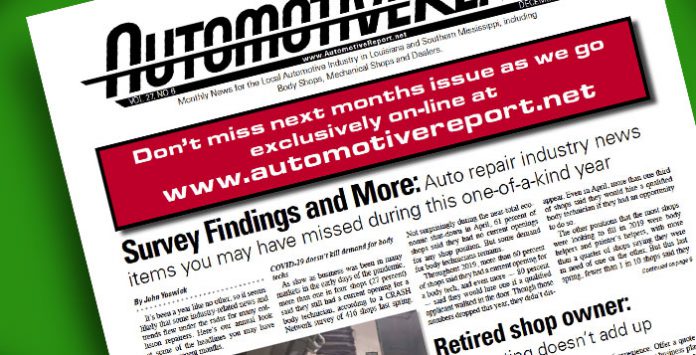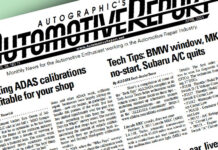Industry news items you may have missed during this one-of-a-kind year
By John Yoswick
It’s been a year like no other, so it seems likely that some industry-related news and trends flew under the radar for many collision repairers. Here’s our annual look at some of the headlines you may have missed in recent months.
COVID-19 doesn’t kill demand for body techs
As slow as business was been in many markets in the early days of the pandemic, more than one in four shops (27 percent) said they still had a current opening for a body technician, according to a CRASH Network survey of 416 shops last spring. Not surprisingly during the near-total economic shut-down in April, 61 percent of shops said they had no current openings for any shop position. But some demand for body technicians remains.
Throughout 2019, more than 60 percent of shops said they had a current opening for a body tech, and even more — 80 percent — said they would hire one if a qualified applicant walked in the door. Though those numbers dropped this year, they didn’t disappear. Even in April, more than one third of shops said they would hire a qualified body technician if they had an opportunity to do so.
The other positions that the most shops were looking to fill in 2019 were body helpers and painter’s helpers, with more than a quarter of shops saying they were in need of one or the other. But this last spring, fewer than 1 in 10 shops said they were looking to fill openings in those positions.
Collision repairs costs rise — or do they?
Collision claims severity made a sizable jump for the second consecutive year in 2019, according to data from ISO (a Verisk Analytics business). The data shows the average collision claim last year rose to $3,750, up 4.81 percent from $3,574 in 2018, adding to the 4.3 percent increase in 2017. That is far higher than the average annual increase of just 1.8 percent over the prior 10 years, and makes the average collision claim in 2019 nearly 35 percent higher than the most recent low of $2,778 in 2010 during the recession. Over the past 20 years, collision severity has now officially doubled, up 100 percent since 1999.
Those may seem like big increases, but once inflation is taken into account, the real cost of collision repairs today is only slightly higher than it was 20 years ago — and far below where it was in the early 2000s. Adjusting the data for inflation, using 1999 as the base year, collision claim severity last year was just $92 more than the $2,352 it was in 1999, an increase of 3.9 percent.
On an inflation-adjusted basis, collision claims severity peaked prior to the last recession, with the average severity in 2004 reaching $2,716 in 1999 dollars. Taking inflation into account shows that the average collision claim severity has fallen 10 percent since 2004.
More shops using materials invoicing systems
A “Who Pays for What?” survey this year, conducted by Collision Advice and CRASH Network, found the percentage of shops using a materials invoicing system is still low — but has been growing.
The survey of more than 700 shops around the country found that although more than seven in 10 shops still rely on the traditional multiplier method (dollars per refinish hour) to attempt to cover their cost of paint and materials, 28 percent are using an invoicing system such as Mitchell’s Refinish Materials Calculator or just the shop’s paint scale. That’s up from just 19 percent in the same survey five years ago.
While insurers have not universally warmed up to invoicing systems, the majority of shops who use them say they are paid by the eight largest insurers “always” or “most of the time” when they bill based on the charges calculated by their invoicing system. Shops report that with the exception of Geico, the top eight insurers all agree to the invoiced amount 60 percent to 70 percent of the time, and the survey data indicates that has been the case for at least the past four years.
Shop consultant and trainer Mike Anderson of Collision Advice said now may be a good time to make the switch before more complicated refinish procedures, with special materials, become increasingly common.
“I think this is going to become important as we start to see more three-stage and four-stage finishes, as well as more limited-use toners that shops may not stock because they are only infrequently used or have limited shelf-life,” Anderson said. “I believe the shift toward invoicing will continue, and that the trend toward using the paint scale to create invoices will continue as more paint companies integrate their scales and systems with the shop management systems.”
The survey findings are available at www.crashnetwork.com/collisionadvice.
Audatex feature called ‘inconsistent’
The Society of Collision Repair Specialists (SCRS) this year challenged what it calls “an inconsistency” in the Audatex feather, prime and block digital tool.
SCRS says its concern is two-fold. First, it says, Audatex’s estimating reference manual in 2007 indicated that labor and materials for feather, prime and block was not-included in Audatex times for replacing a welded panel. But later versions of the reference manual state only that labor and materials for feather, prime and block are not-included in Audatex times for repaired panels, without referencing welded panels.
SCRS says that in 2008, Audatex told the Database Enhancement Gateway that labor times for welded panels include feather, prime and block, and SCRS has questioned if the change was made without any adjustment to the labor times.
SCRS’ second and related concern is that the feather, prime and block operation can require the use of materials regardless of whether it is being performed on a repaired panel or a welded-on replacement part. Yet Audatex, the association says, provides a means for determining a charge for those materials based on labor times only for user-defined repaired panels, not for Audatex-defined welded replacement panels. For welded replacement parts, SCRS states, “there is no breakout of what labor has been assigned to the operation of feather, prime and block in the labor report, and no way to reflect it on the repair plan, and no way to capture materials.”
SCRS calls this “an inconsistent approach” that is “inhibiting repair facilities from being able to capture the labor or materials on welded replacement operations.”
Audatex and SCRS agree this is an issue the two have had multiple discussions about “over the years,” both in writing and in-person meetings.
“We recognize that some members of SCRS would prefer that our products detail, as a line item, the time involved in the feather, prime and block processes relating to replacement of welded-on panels,” Audatex states in a recent written response to SCRS. “That is not an option currently available in our product.”
The determination of material costs for that operation, Audatex states, “is best provided by the estimate preparer for consideration and allowance during the estimate preparation process.”
Audatex says some shops consider feather, prime and block as part of the preparation for paint while others consider it as part of the welding repair operation.
“Our system, as explained in our reference manual, considers the process as part of the welding repair operation and includes the time for the process in the time allotted for the welded panel replacement,” Audatex told SCRS.
Audatex said its time studies have found that its labor times are appropriate for all included operations, and adds that SCRS’ request for changes to its documentation and methodology “should not overshadow the fact that no one has questioned the sufficiency of the repair times in our product to include the stated operations.”
Many shops decline insurers’ credit cards
The owner of a three-shop collision repair business this fall said The Hartford (for which the MSO is a DRP) was asking his company to sign up for the insurer’s “virtual payables initiative,” which will enable The Hartford to pay for claims via credit card. In its notice to the MSO, The Hartford says the switch will “accelerate payments” and “reduce paperwork.” The owner of the MSO, however, was concerned about the added credit card processing fees this would cost his company.
“Depending on the deal a shop has [for processing], this could be 1.75 percent to 3 percent off the top,” he said.
At least one other small MSO on The Hartford’s DRP in another state said they had not heard about the ‘virtual payables’ program. But other shops said it should not be a concern.
“They have asked us for this, but we refused and requested a check, and they have complied with our request,” the president of a four-shop MSO in the Midwest said.
Indeed, no one from The Hartford is saying participation in the credit card payment program is required. A Northern California shop owner who participates in The Hartford’s DRP had similar concerns about the processing fees.
“We declined, and they did give us that option,” the shop owner said.
Several shops said they have had isolated requests by some insurers to pay by credit card on a given job.
“We just added the fees back into the estimate on those,” the owner of a small MSO in the Southeast said.
“Nationwide tried that a while back, giving customers pre-paid Visa cards,” a shop owner in the Pacific Northwest said. “We just declined to accept those and held the cars until a check or electronic funds transfer arrived.”
Not all shops are opposed to accepting credit card payments from insurers.
“I see why some shops wouldn’t want to do it, but I don’t really care as long as I get the money right away,” the owner of another three-shop MSO, which does take credit card payments from The Hartford, said. “We have some others that pay by credit card, too, and on many of them we can add the fees to the estimate.” •
John Yoswick, a freelance writer based in Portland, Ore., who has been writing about the automotive industry since 1988, is also the editor of the weekly CRASH Network bulletin (www.CrashNetwork.com). He can be contacted by email at john@CrashNetwork.com.



